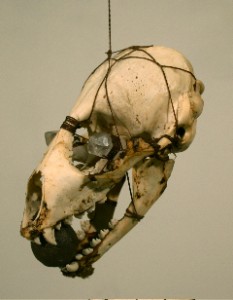
David Olsen, "Witness," mixed media, 2008.
The last artist I’ll include in my discussion of earnestness, or what one might also call exuberant seriousness, is David Olsen, a sculptor who has spent the last several years documenting actions using his work on Newtown Creek in Brooklyn. The creek is one of the most polluted waterways in the country, and the sculptures are, in a certain sense, tools for healing. Made from natural materials like clay, wax, and rope, they employ humble filtration devices to purify tiny amounts of water, or crystals intended to absorb negative forces. One recent work, Witness (2008), is a seal skull with crystals embedded in the eye sockets. A rope attaches the skull to a glass buoy, so when it is lowered into the water it can float through the depths, “seeing” and collecting information or negative energy, until it is retrieved by the artist. Olsen adopts the identity of “Vulture” for these actions, wearing a handmade protective helmet and suit to mimic the bird’s heightened immune system. Of course, these activities have negligible impact on the rampant pollution of the waterway. Olsen’s deliberate mixing of pragmatic and mystical solutions to the problem further obfuscate their effectiveness, while retaining the urgent desire for change.
These past few weeks, I’ve clearly chosen artists working not only in a variety of different media but also in different historical contexts and with divergent concerns, but perhaps there is something Stuart Sherman, Eve Essex, Bibi Calderaro, and Olsen all share: the desire to make an offering while leaving the reaction or result open-ended. Sherman once claimed, “I’m influenced the most by myself as a child. I don’t feel so very different from when I was 5.” Yet the complex work I’ve discussed is not naïve. It recalls the pure childish gesture of opening one’s hand simply to show what is in it, shaded with the adult knowledge that there is a peculiar strength in such simplicity.
David Olsen, "Vessel Placement," 2008.